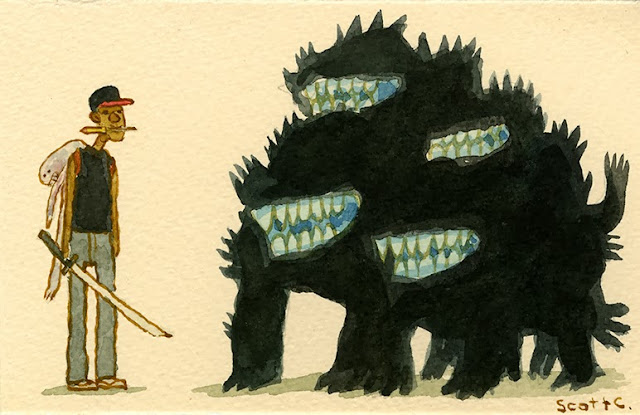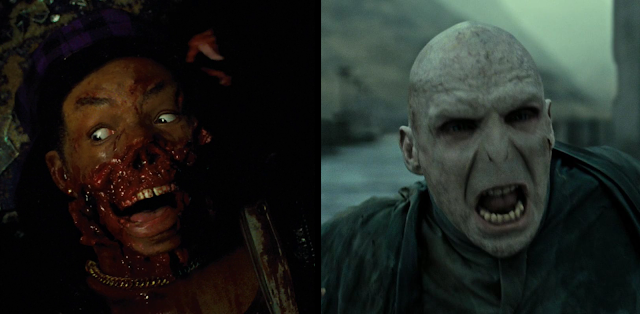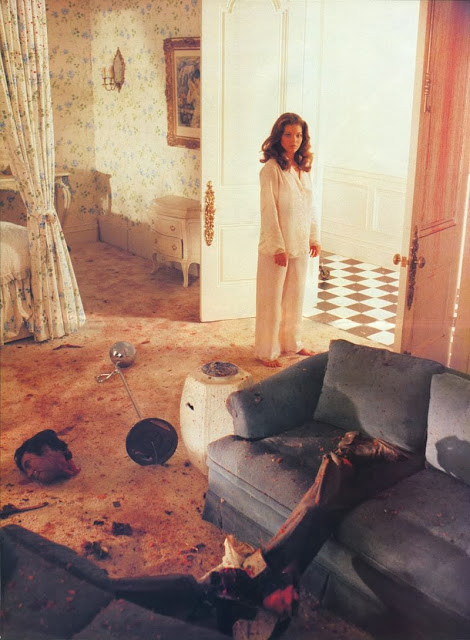Attack the Block
Set in a rough South London neighborhood attacked by "gorilla wolf muthafuckas" from outer space, the 2011 Edgar Wright-produced cult favorite Attack the Block is inventive sci-fi with a youth of color as the lead for a change. Hoodie leader Moses (John Boyega) and his crew find themselves dealing with alien invaders, as well as two much more typical South End threats: the Five-0 and a trigger-happy drug lord named Hi-Hatz (Jumayn Hunter). The film doubles as an inspired, non-preachy critique of the demonization of the working class in the U.K. A one-time mugging victim who wanted to better understand his muggers and their lives instead of being resentful and fearful of them, writer/director Joe Cornish takes working-class kids like Moses and the brainy Jerome (Leeon Jones) (their mugging of Jodie Whittaker's nurse character Sam at the start of the film was based on the incident Cornish experienced) and fleshes out those characters to prove the irrationality of demonizing the underclass. (Had Attack the Block been a much bigger hit in America, it would have caused that racist dickcheese Lou Dobbs to get his panties in a bunch over the kinds of characters it chooses to sympathize with.) What also makes Attack the Block stand out is the absence of CGI. All the creature FX in Cornish's film are practical. The alien attacks are fast and brutal, and this is a case where the fast-cutting that so many critics complain about when they see present-day action movies is absolutely necessary because here, it prevents us from noticing how cheap-looking the monsters are--they're essentially just stuntmen leaping around in eyeless and coal-black bear suits outfitted with ginormous blue neon teeth. But because the Attack the Block aliens aren't CG, there's a realness and formidability to them that's missing from most CG creatures. Attack the Block is more of a sci-fi actioner than a genuinely scary horror film, although it contains one horrific moment: the split-second shot of a mutilated Hi-Hatz doing his best impression of Voldemort.
Dawn of the Dead (1978)
Danny Boyle's 28 Days Later was my gateway to the zombie genre when the Boyle film first hit DVD, and it led me to check out for the first time George Romero's 1978 follow-up to his breakthrough zombie film Night of the Living Dead. The 1968 film was straightforward apocalyptic horror, while Dawn of the Dead, which centers on a pack of zombie attack survivors who hole up in a Pennsylvania shopping mall, throws satire into the mix. The mall backdrop and the survivors' gradual immersion into mall culture while biding their time both serve as a clever commentary on the downside of consumerism. The sequence where zombies turn an unlucky biker gang into a SAMCROnut buffet still holds up as grisly horror makeup FX wizardry. What doesn't hold up so well are a few non-FX-related elements that are a result of the film's low budget, like a really terrible, Mr. Peabody & Sherman-esque library music cue that drops when lead hero Ken Foree reconsiders killing himself and shoots and punches his way out of the mall.
Dawn of the Dead (2004)
Zack Snyder's first feature film still remains his best directorial effort. Duplicating the satire of the original Romero film would have been a pointless effort, so Snyder focused more on the action side of the material, and that's the one aspect where this remake outdoes the original. The Romero version is stronger as a satirical horror film, while the Snyder film is much better at action and suspense (the film's first few minutes, in which Sarah Polley watches the zombie apocalypse erupt, are still a corker). The Snyder version isn't without a humorous side though: the rooftop sequence where the survivors assign celebrity nicknames to zombies they use as target practice is genuinely funny, as is a pre-Modern Family Ty Burrell as the douchiest of the survivors.
Evil Dead II
Groovy.
The Fury
The original Carrie is a far better Brian De Palma horror flick. But the lesser-known 1978 De Palma bloodbath The Fury, which was three years ahead of David Cronenberg's Scanners as a hybrid of espionage thriller and psychokinetic horror flick, has its charms, like crazy gore FX by Rick Baker and William Tuttle, an intense John Williams score, a villainous turn by John Cassavetes and the sight of one of the greatest pioneers of indie cinema exploding into several pieces, still my favorite movie ending ever.
The Host (2006)
The inspiration for Korean director Bong Joon-ho's The Host (known in its home country as Gwoemul, which is Korean for "monster") was a February 2000 incident where an American mortician who worked for the U.S. military in Seoul ordered his workers to dump toxic chemicals into the sewer system connected to the Han River, the source of drinking water for over 20 million Koreans. In The Host, a similar 2000 incident, caused by a clueless pathologist played by The Walking Dead's Scott Wilson, leads to the creation of a giant fish mutation that emerges from the Han River and is looking for people-shaped dinner. Lazy screw-up Park Gang-du (Kang-ho Song), who runs a snack stand by the river with his father Hie-bong (Hie-bong Byeon) and is single dad to 12-year-old Hyun-seo (Ah-sung Ko), witnesses the creature's rampage and runs for safety with his daughter, but the creature snatches Hyun-seo away from a shocked Gang-du and takes her with it into the river. The rescue effort that ensues is an unconventional but compelling mix of monster movie thrills, dysfunctional family comedy and political satire about the incompetence of both American and Korean institutions. It became the biggest-grossing movie in South Korean history. The creature at the center of this Korean box-office sensation was brought to life by the San Francisco FX house The Orphanage and New Zealand's Weta Workshop and is a rare example of "when keeping it CG doesn't go wrong." The FX team imbued the creature's movements with personality and a clumsy gait that cleverly mirrors the klutziness of Gang-du, who, together with his unemployed political activist brother Nam-il (Hae-il Park), their archery champion sister Nam-joo (Doona Bae) and their dad, form a pack of fascinating--and as we see in the scene where grief over a thought-to-be-dead Hyun-seo turns into a chaotic gym floor slapfight, very funny--anti-heroes. These characters are Bong's way of placing everyday people in a central role that's usually reserved in monster movies for scientific geniuses or muscle-bound heroes, characters Bong finds to be less dramatically interesting than the likes of the Park family. That groundedness even informs the behavior of the creature, whose puking of human bones during The Host's most nightmarish scene was drawn from Amazonian anaconda behavior Bong saw during animal shows. The creature's vomit session apparently frightened the audio out of the sewer scene clip that was posted by Movieclips.com.
Planet Terror
If you're noticing a pattern here--almost all these works are action flicks with horror elements--then yes, I'm more of an action guy than a horror guy. In Robert Rodriguez's entertaining Planet Terror, Freddy Rodriguez (no relation)--or his stunt double--runs up a hospital hallway wall and backflips off it to stab a zombie, and Rose McGowan mows down hordes of them with a machine gun leg. Those are two things that differentiate Rodriguez's fast-paced and lighthearted crowd-pleaser (peep the nifty DVD commentary track that solely consists of audience reactions at a Planet Terror screening) from the slow-zombie, mostly gloomy George Romero take on the genre. If you enjoy some of Quentin Tarantino's directorial efforts but you find Tarantino irritating as either an actor or a white guy who wants to be black--or if you don't like Tarantino at all--you get to see him die in Planet Terror in the most horrific way a character played by Tarantino has ever bought it.
Quatermass and the Pit
Like the two '60s Doctor Who feature films that starred Peter Cushing as the Doctor, 1967's Quatermass and the Pit is a remake of a BBC sci-fi serial, one of several serials featuring the character of Bernard Quatermass (pronounced "KWAY-ter-mass"), a heroic British professor who's played in the 1967 film by Andrew Keir (Luther creator Neil Cross wanted to write his recent Doctor Who episode "Hide" as a Doctor Who/Quatermass crossover--Jon Pertwee's run as the Doctor was modeled after Quatermass--but rights issues caused the crossover to be squashed). The original late '50s Quatermass and the Pit serial can be glimpsed in its entirety on YouTube, while this film version isn't as easy to track down in America (a late '90s Stateside DVD release went out of print), unless you have a multi-region Blu-ray player or TCM, which sometimes airs the film. Retitled Five Million Years to Earth in America, the low-budget thriller was produced by England's beloved Hammer horror film studio, and it's the only Hammer film I've been able to get into (if I ever have the patience for Victorian horror, maybe I'll marathon all those Hammer naked vampire flicks or Christopher Lee Draculas someday). Quatermass and the Pit is more of a cerebral sci-fi piece than a horror film, but its clever concept of a Martian master plan of ethnic cleansing on Earth--scores of present-day humans are the descendants of cavemen who were abducted by Martians who implanted the cavemen and their descendants with telekinetic powers to eliminate all humans who are different from them--is quite creepy. It's also an amusing way to explain the roots of racism. Marvin Martian made you racist!
Shaun of the Dead
"I just discovered Shaun of the Dead is one of Elvira's favourite movies. The 14 year old boy in me exploded," tweeted Edgar Wright, director of the 2004 cult classic that kicked off his hilarious Cornetto trilogy. What is there not to love about Shaun of the Dead? I love how Shaun, who's so accustomed to his drab morning routine, doesn't notice the zombie apocalypse at first and mistakes a zombie for a homeless guy. I love how the film looks like it was shot for three times its £4 million budget during that ambitious single-take shot of Shaun's oblivious walk from his crib to the newsagent (the British term for a store that sells newspapers and snacks) and back. I love how Shaun and Ed laugh at the first zombie they encounter ("Oh my God, she's so drunk!"). I love how Shaun and Ed get choosy about which LPs to use as shurikens against the zombies. I love how the film shifts from comedy to pathos as seamlessly as some of the best episodes of Wright's breakthrough work Spaced--and now The World's End, Wright's final Cornetto film--do. I love how one of the extras who played the zombies tuned in to AFOS and once e-mailed me (I think he was Hulking Zombie; I still might have audio of myself reading his e-mail, but tracking down that audio to verify his zombie role in the film is like looking for a Cornetto treat in California). And I'm still waiting for Wright to make Yvonne of the Dead or whatever he'd call the Rosencrantz and Guildenstern Are Dead-style off-screen adventure that's hinted at during Simon Pegg's scenes with his old Spaced co-star Jessica Hynes.
Tales from the Hood
Until Attack the Block came along, Fear of a Black Hat star/writer/director Rusty Cundieff's 1995 anthology film Tales from the Hood, which was produced by Spike Lee and concludes memorably with Clarence Williams III going H.A.M. and hissing, "Welcome to hell, motherfuckers!," was the most entertaining mash-up of a hood movie and a creature feature (sorry, Snoop Dogg's Bones). It's easy to forget that In Living Color and Chocolate News star David Alan Grier is also a serious actor (his first feature film was Robert Altman's 1983 Vietnam War drama Streamers), and in Tales from the Hood's "Boys Do Get Bruised" segment, Grier got to revisit his non-comedic side as a man whose abusive treatment of his girlfriend (Paula Jai Parker) and her son (Brandon Hammond) causes the kid to turn to unusual measures to protect himself and his mother. Tales from the Hood is also best remembered for pitting racist politician Corbin Bernsen against dead slaves who return to life as voodoo dolls (which sounds on paper like some surreal sketch Cundieff would have directed when he later worked on Chappelle's Show) and the black-on-black-crime-themed "Hard Core Convert," the harrowing segment that borrowed from both A Clockwork Orange and Ambrose Bierce's "An Occurrence at Owl Creek Bridge." In "Hard Core Convert," the late Rosalind Cash played a scientist who subjects an incarcerated gangbanger (the late Lamont Bentley) to an experiment that's intended to deprive him of his murderous impulses. The gangbanger's other punishment is that he's forced to wear goofy-looking bikini briefs straight out of John Travolta's Staying Alive.
The Thing (1982)
A box-office flop when it first dropped during the summer of E.T., John Carpenter's remake of the 1951 monster movie The Thing from Another World is, to me, slightly more impressive than even a well-done sci-fi horror film like 1979's Alien because unlike Alien, it confines itself to a single setting and it doesn't have a happy ending. Plus the additional touch of mistrust between the Antarctic researcher characters--due to the titular creature's ability to assume any form--amps up the film's tension so effectively. The Thing's scenes of discord within the dwindling group of victims have influenced everything from The X-Files' "Ice" episode to The World's End. The Carpenter film contains the grossest imagery out of these 11 films (on network TV, much of that imagery was cut from the film, like the disembodied head that sprouts spider legs and tries to crawl away). All that imagery was accomplished in the pre-CGI days of visual FX through painstaking practical FX work by both Rob Bottin and--when Bottin wound up so physically exhausted from his workload on The Thing that he had to call in another FX genius to help him out--the late Stan Winston. Kurt Russell's reaction to seeing the Thing emerge in the largest and most monstrous form that Bottin and his FX team could come up with is classic Carpenter ("Yeah, fuck you too!"). If you ever wanted to hear what the toughest of men sound like when they stop being macho and are scared shitless and start screaming, peep The Thing's blood test scene--or all of Predator.
Original music from Attack the Block, The Host, Planet Terror, Tales from the Hood and The World's End can be heard during the "Buckets of Score" block from 5pm to 11pm on Halloween night on AFOS.
 |
| Attack the Block by Scott C. |





No comments:
Post a Comment